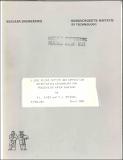A core reload pattern and composition optimization methodology for pressurized water reactors
Author(s)
Sauer, Ildo Luis; Driscoll, Michael J.
Download855647023.pdf (14.22Mb)
Other Contributors
Massachusetts Institute of Technology. Department of Nuclear Engineering
Metadata
Show full item recordAbstract
The primary objective of this research was the development of a comprehensive, rapid and conceptually simple methodology for PWR core reload pattern and fuel composition optimization, capable of systematic incorporation of constraints, in which cycle burnup is defined as the optimality criterion. A coarse mesh nodal method for PWR core analysis was formulated by coupling the one-and-one-half-group diffusion theory model for spatial power calculations with the linear reactivity versus burnup model (LRM) for depletion calculations. The accuracy and suitability of this model was determined through comparisons of its results with those of state-of-the-art core analysis methods. The simplicity of the LRM-based core model allowed the direct analytical computation of the derivatives necessary in the steepest gradient type optimization methods applied in the present work, and its versatility permitted use of the analytical and computational methods for a variety of applications, ranging from core reload pattern searches to burnable poison (BP) and composition optimization. Algorithms for identification of unconstrained maximum-burnup core reload patterns and for optimal BP allocation were successfully implemented and tested, and the basis for systematic incorporation of constraints on power peaking was developed. The potential application of the methodology to fuel composition optimization was also examined. Most of the methodological developments have been embodied in the LRM-NODAL code which was programmed in the course of this research. From the numerical and analytical results it was found that the optimal core configurations are arranged such as to produce power histories and profiles in which the most reactive assemblies are at their highest allowable power at EOC (thus maximizing their importance) and where the converse applies to the least reactive; these preferred profiles also produce relatively higher leakage at EOC, evolving to the lowest possible leakage at EOC, but always consistent with the maximization of the core reactivity importance.
Description
"March 1985." Originally issued by the first author as a Ph. D. thesis, Massachusetts Institute of Technology, Dept. of Nuclear Engineering, 1985 Includes bibliographical references (pages 277-283)
Date issued
1985Publisher
Cambridge, Mass. : Dept. of Nuclear Engineering, Massachusetts Institute of Technology, [1985]
Series/Report no.
MITNE ; no. 266